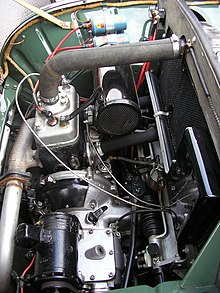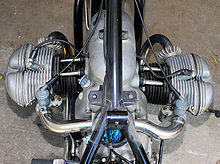Transverse and longitudinal engine

Transverse or longitudinal engine refers to the installation position of an internal combustion engine in a motor vehicle . In the case of the transverse engine, the crankshaft of the engine is perpendicular to the direction of travel, and the longitudinal engine in the direction of travel. This definition is independent of the design of the engine, regardless of whether it is an in-line boxer or V-engine , even if this can easily be irritating, as a "longitudinally" installed boxer engine is often wider than it is long, for example on two-cylinder motorcycles.
Transverse and longitudinal engine in cars
Most front-wheel drive cars have transversely installed in-line engines, cars with rear-wheel drive have front longitudinally mounted engines usually. Engines installed across the rear axle (under the driver's seat) were also used by some American types before the First World War , such as those from Ford, Packard or Olds . The first production vehicle with a transverse engine and front-wheel drive was the DKW F1 in 1931 . This concept with the motor behind the axle and the primary drive with a chain was retained by its successors until after the Second World War .
The Saab 92 appeared in 1947 . In his case, the engine and transmission sat next to each other in front of the axle, as in modern vehicles. The Goliath GP 700 and the Lloyd 300 from the Borgward group (both released in 1950) were also built in this way. IFA ( Automobilwerk Zwickau ) adopted this concept for the Trabant (1957). NSU built vehicles with a transverse engine in the rear, glass , then BMW until 1969. From 1965, Lamborghini manufactured the Miura with a transverse 12- cylinder engine in front of the rear axle.
In 1959, the Mini was a handy small car with a transverse front engine, in which the gearbox is located under the engine. The car also successfully participated in various rallies. In 1962 the compact car BMC ADO 16 appeared (initially as the Morris 1100), which in its various variants became the best-selling car on the British market in the 1960s. Transverse engines were no longer perceived as a makeshift solution in underpowered small cars and scooter mobiles.
The Italian automobile designer Dante Giacosa designed Fiat 's 1964 model Autobianchi Primula, the most widely used design with drive shafts of unequal length . Four-cylinder engines also fit next to the transmission. Before, either (short) two-cylinder engines were used or the gearbox was located under the engine in the oil sump.
Thirty years after the appearance of the DKW F1, the knowledge spread that this type of construction is cheaper to manufacture and, above all, has better functional properties than the conventional type with rear engine or standard drive (engine in front and driven rear wheels). Between 1965 and 1980, almost all major automobile manufacturers presented at least one model based on this model.
The length of a transverse engine is limited by the width of the automobile. There are transversely installed five-cylinder in- line engines with a displacement of over 2.4 liters, for example in the compact Fiat Stilo . A short eight-cylinder V-engine with a displacement of around 4.4 liters is available in the Volvo XC90 as a transverse engine, as is the Volvo S80 , which is also available with a six-cylinder in-line engine with a displacement of around 3.2 liters. From 1964, the British manufacturer BMC offered the ADO17 type as Austin 2200, Morris 2200 and Wolseley Six with a transverse six-cylinder engine and a gearbox installed underneath. In 1985 a V8 engine was installed transversely in the Cadillac Seville .
Omnibuses
Even modern buses with low-floor technology usually have a transverse engine in the rear . It is easily accessible for maintenance work.
motorcycles
see also longitudinal and transverse runners
In motorcycles with chain drive of the rear wheel, the crankshaft perpendicular to the direction of travel dominates. The advantage is that all of the shafts in the transmission, including the sprocket shaft, are transverse and no right-angled torque transmission is required. With cardan shaft drives, on the other hand, there is no need for a second angular gearbox for engines with a crankshaft almost in the direction of travel. Examples are various boxer engines (e.g. Hoffmann Gouverneur , (IFA) BK 350 , Zündapps two-cylinder types, many BMW types ) and various V-engines . (e.g. Victoria V 35 Bergmeister , Moto Guzzi , Zündapps two-cylinder types with 170 ° arrangement of the cylinder rows). Longitudinal inline engines were available from FN from 1905 , in the 1920s and 1930s from Henderson / Indian , Nimbus and later from various BMWs and the Triumph Rocket III, among others .
The shape of the "transversely" installed boxer - like the white Mars with chain drive - can now be regarded as extinct, but was the standard installation position for boxer engines in motorcycles until around 1930. Examples of “transverse” V-engines are Harley-Davidson and many more recent Japanese models.
Individual evidence
- ↑ Autobianchi Primula, A 111 - 1964-72
- ↑ Fiat Stilo 2.4 20V Abarth. (No longer available online.) In: Auto Zeitung . Archived from the original on June 24, 2014 ; Retrieved June 25, 2014 .
- ↑ The slender grace of the maternal moose . In: FAZ . February 28, 2006 ( faz.net [accessed June 25, 2014]).
- ↑ Volvo S80: Flagship freshly launched . Handelsblatt . July 5, 2006. Retrieved June 25, 2014.
- ↑ The cars: BMC 1800/2200 development history

